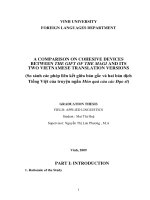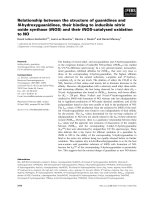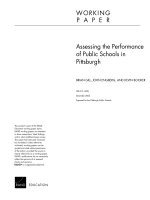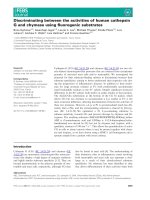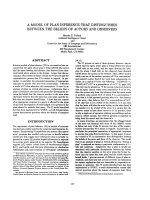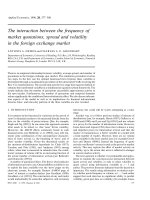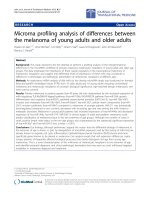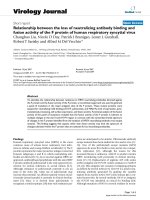Interfacial effects between the structured nanofillers and nafion matrices on the performance of h2 PEM fuel cell
Bạn đang xem bản rút gọn của tài liệu. Xem và tải ngay bản đầy đủ của tài liệu tại đây (9.77 MB, 221 trang )
INTERFACIAL EFFECTS BETWEEN THE STRUCTURED
NANOFILLERS AND NAFION MATRICES ON THE
PERFORMANCE OF H
2
-PEM FUEL CELL
GUO BING
NATIONAL UNIVERSITY OF SINGAPORE
2012
INTERFACIAL EFFECTS BETWEEN THE STRUCTURED
NANOFILLERS AND NAFION MATRICES ON THE
PERFORMANCE OF H
2
-PEM FUEL CELL
GUO BING
(M. ENG., National University of Singapore)
A THESIS SUBMITTED
FOR THE DEGREE OF DOCTOR OF PHILOSOPHY
DEPARTMENT OF CHEMICAL & BIOMOLECULAR
ENGINEERING
NATIONAL UNIVERSITY OF SINGAPORE
2012
i
ACKNOWLEDGEMENT
First, I wish to express my deepest appreciation and thanks to my supervisors,
associate Professor Hong Liang and Dr. Liu Zhaolin from IMRE, for their guidance
and encouragement throughout my candidature as a Ph.D student at the National
University of Singapore (NUS). Professor Hong’s comprehensive knowledge and
incisive insight on polymer materials, uncompromising attitude toward research as
well as the insistence on quality works have deeply influenced me and will benefit my
future study. His invaluable advice, patience and painstaking revisions of my
manuscripts and this thesis are indispensable to the timely completion of this thesis. I
am also grateful to Dr. Liu Zhaolin for his immense background and experience in
electrochemical knowledge which enabled me to work through many problems
smoothly.
I would also like to express my gratitude to my colleagues Mr Chen Xinwei, Chen
Fuxiang, Liu Lei, Sun Ming, Zhou Yien, Ms Wang Haizhen, and Dr Tay Siok Wei of
IMRE for all the handy helps, invaluable discussion and suggestions. I am grateful for
the Research Scholarship from NUS that enables me to pursue my Ph.D. degree. I am
also indebted to the Department of Chemical & Biomolecular Engineering of NUS for
the research infrastructure support.
Last but not least, this thesis is dedicated to my parents, my husband and my lovely
daughter for their great understanding and steadily moral support throughout my Ph.D
program.
ii
TABLE OF CONTENTS
ACKNOWLEDGEMENT i
TABLE OF CONTENTS ii
SUMMARY v
ABBREVIATION viii
LIST OF FIGURES xiii
LIST OF TABLES xvii
LIST OF SCHEMES xviii
CHAPTER 1 INTRODUCTION 1
1.1 General background 1
1.2 Objectives and scope of this thesis 4
1.3 Organization of This Thesis 7
CHAPTER 2 LITERATURE REVIEW 10
2.1 Proton exchange membrane Fuel Cell (PEMFC) and current status 10
2.1.1 Basic physical and chemical properties of SPFP-Nafion 16
2.1.2 Proton transport mechanism 23
2.1.3 Contemporary tactics for enhancing the cell performance of Nafion
membrane 27
2.2 Nafion-based nanocomposite membranes 30
2.2.1 Nanoparticles dispersed in Nafion membranes 31
2.2.2 Nanotubes dispersed in Nafion membranes 36
2.2.3 Mesoposous materials dispersed in Nafion membranes 43
2.2.4 Other materials dispersed in Nafion membranes 46
2.2.5 Process technology 59
CHAPTER 3 DOPING NAFION
MATRIX BY P-ARAMID FLAKES FOR A
PROTON TRANSPORT LESS RELIANT ON MOISTURE 62
3.1 Introduction 62
3.2 Experimental 66
3.2.1 Materials 66
3.2.2 Synthesis and characterizations of oligomeric poly(p-phenylene
terephthalamide) 66
3.2.3 Preparation of the Nafion-P105 composite membranes 67
3.2.4 Electron microscopy and
19
F-NMR spectroscopy characterizations. 68
3.2.5 Thermal Analysis 69
3.2.6 Measurement of the properties of the colloidal suspensions 69
3.2.7 Determination of water uptake and contact angle 70
3.2.8 Evaluation of electrochemical properties 71
iii
3.3 Results and discussion 72
3.3.1 Colloidal evidences for the interaction between P105 and Nafion molecule 72
3.3.2 Properties of the composite membrane composed of Nafion-P105 clusters 83
3.3.3 Proton transport in the composite matrix 89
3.4 Conclusions 94
CHAPTER 4 SUBSTITUTED POLY (P-PHENLENE) OLIGOMER AS A
PHYSICAL CROSSLINKER IN NAFION
MEMBRANE 95
4.1 Introduction 95
4.2 Experimental 99
4.2.1 Materials 99
4.2.2 Preparation of monomer 1, 4-dibromo-2,5-diacetoxybenzene (DBOAcB) 99
4.2.3 Preparation of poly-p-phenylene-2, 5, diacetoxy (POAc) (scheme 1) 100
4.2.4 Preparation of Nafion-POAc composite membranes 100
4.2.5 Structural characterizations 101
4.2.6 Measurement of intrinsic viscosity 101
4.2.7 The morphologies of membranes 102
4.2.8 Thermal analysis of the cast membranes 103
4.2.9 Determination of water uptake and ionic exchange capacity (IEC). 103
4.2.10 Evaluation of electrochemical properties 104
4.3 Results and Discussion 104
4.3.1 Synthesis of POAc and examination of the interactions between POAc and
Nafion in a dilute colloidal suspension 104
4.3.2 Characterizations of the Nafion-POAc composite membranes 109
4.3.3 Electrochemical evaluation of the Nafion-POAc membranes 114
4.4 Conclusions. 118
CHAPTER 5 ASSIMILATION OF HIGHLY POROUS SULFONATED
CARBON NANOSPHERES INTO NAFION MATRIX AS PROTON AND
WATER RESERVOIRS 120
5.1 Introduction 120
5.2 Experimental 122
5.2.1 Preparation of sulfonated porous carbon nanospheres (sPCNs) 122
5.2.2 Preparation of the Nafion-Carbon composite membranes 123
5.2.3 Structure characterization 124
5.2.4 Thermal Analysis of the membranes 124
5.2.5 Determination of water uptake and Ionic Exchange Capacity (IEC) 125
5.2.6 Evaluation of electrochemical properties 125
5.3 Results and discussions 126
5.3.1 Synthesis of sulfonated porous carbon nanospheres (sPCNs) 126
iv
5.3.2 The structure characteristics of the Nafion-sPCN composite membranes 130
5.3.3 Examination of hydrophilic phase in the Nafion-sPCN composite
membranes 137
5.3.4 Electrochemical evaluation of the Nafion-Carbon membranes 139
5.4 Conclusions 144
CHAPTER 6 EMBEDDING OF HOLLOW POLYME MICROSPHERES
WITH HYDROPHILIC SHELL IN NAFION MATRIX AS PROTON AND
WATER MICRO-RESERVIOR 146
6.1 Introduction 146
6.2 Experimental Section 148
6.2.1 Materials 148
6.2.2 Synthesis of SiO
2
-MPS nanoparticles 148
6.2.3 Synthesis of SiO
2
/polymer core-shell nanoparticles 149
6.2.4 Synthesis of hollow polymer nanopheres (HPS) 150
6.2.5 Fabrication of the composite membranes 150
6.2.6 Characterization. 151
6.3 Results and Discussion 153
6.3.1 Characteristics of the HPSs 153
6.3.2 Broadening hydrophilic channel of Nafion by hydrophilic HPS 155
6.3.3 Effects of water micro-reservoir in the composite membranes 158
6.3.4 Influence of Moisture Level on Proton Transport in the Composite
Membranes 163
6.4 Conclusions. 169
CHAPTER 7 CONCLUSIONS AND RECOMMENDATIONS 170
7.1 Conclusive remarks on my Ph.D work 170
7.2 Recommendations for future work 174
REFERENCES 177
LIST OF PUBLICATIONS 201
v
SUMMARY
The development of the proton exchange membrane fuel cell (PEMFC) has been an
intense research area of which the goal is clear: to ensure a long service life without
compromising performance (power density) and stable energy output at elevated
temperatures (70-120
o
C) so as to meet the demands of commercialization. Since the
application of traditional PEM (Nafion) was constrained by the operation temperature
(below 80
o
C) and relative humidity (RH) level (above 80%), the current focus of
membrane research is the pursuit of high proton conductivity at elevated temperatures
with less reliance on water. Four types of special nanofillers were developed in this
thesis with the aim of enhancing proton transport of Nafion. The fillers are:
oligomeric poly (p-phenylene terephthalamide) (PPTA) nanoflakes and poly (p-
phenylene-2, 5, diacetoxy) (POAc) nanorods, sulfonated highly porous carbon
nanospheres (sPCNs) and hollow polymeric nanospheres (HPSs) bearing different
functional groups. They were assimilated into the Nafion matrix by means of solution
dispersion and casting. The elaboration of physicochemical mechanisms behind the
electrochemical behaviours, thermal/mechanical properties in the composite matrix
constitutes the major part of this thesis. The main accomplishments of this thesis are
highlighted below.
Oligomeric PPTA Nanoflakes (about 20nm) were designed first. A low dose of such
nanoflakes in the Nafion matrix causes a reduction in glass transition temperature and
an increase in storage modulus of membrane due to the adsorption of Nafion
molecules to PPTA nanoflakes. The contacts between the –SO
3
H groups of Nafion
vi
and PPTA nanoflakes constitute an alternative proton transfer channel that is less
reliant on moisture levels. The 2% PPTA modified matrix sustains a power density of
450 mw/cm
2
at 70
o
C in a dry gas operated single H
2
PEM fuel cell (H
2
-PEMFC),
much greater than what a pristine Nafion and Nafion-112
membrane would confer.
The oligomeric POAc rigid rod was synthesized as the second type of filler. Both of
the acetyl side groups and the π-system of POAc became acceptors of protons.
Thereby, the side-chain -SO
3
H groups of Nafion molecules attached to POAc rods,
creating an alternative proton transport channel. This association also led to a physical
cross-linking network. It was supported by the variation of glass transition
temperature of Nafion with the increase in POAc content, the UV-vis spectroscopic
study of diluted colloidal system, the morphology of composite matrix as well as the
fusion behaviour of matrix-bound water. The composite membrane with 1 wt% POAc
loading resulted in the highest proton conductivity and the superior power density
(512 mw/cm
2
at 70
o
C) over the pristine Nafion membrane in the single H
2
-PEMFC
operated by dry H
2
.
With respect to the third type of filler, highly porous sulfonated carbon nanospheres
(sPCNs) were prepared from polypyrrole through pyrolysis, alkaline etching and
sulfonation. The adsorption of Nafion molecules to the sPCNs generated a physical
crosslinking network, which includes free Nafion molecules. As a result, a semi-
interpenetrating network (sIPN) was accomplished. However, the sIPN was gradually
replaced by a random assembly of Nafion-wrapped sPCN granules with raising the
vii
sPCN loading to 2wt%. The presence of free Nafion molecules in sIPN is critical to
proton transfer. The porous scaffold of sPCN (1300 m
2
/g) is essential to promote
water-capture and proton transport at elevated temperatures. The composite
membrane with 1 wt% sPCN loading could sustain a power-density of 571 mW/cm
2
in a dry gas operated H
2
-PEMFC at 70
o
C, much greater than that of the pristine
Nafion membrane.
Finally, the hydrophilic hollow polymeric nanospheres (HPSs) carrying sulfonic acid
groups or the carboxylic acid groups were synthesized using silica sub-microsphere as
template. These HPSs are promising candidates because the hollow cavities act as
micro water reservoir and the hydrophilic polymeric largely promotes proton hoping
rate. With the exception of these two prominent effects, the adsorption of –SO
3
H
groups of Nafion on HPSs also improved water preservation at elevated temperatures.
The substantially low density of HPSs rendered HPSs a very high volume fraction. A
loading of 0.2 wt% provided a surface area more than needed for accepting the
sulfonic acid groups of Nafion. As a result, the composite matrix also contained HPSs
free of adsorption, which contributed continuous proton transport channels. This
chapter also scrutinized the freezable bound water and free water in the composite
matrix by using DSC. The trend observed is coherent with ion-exchange capacity,
proton-conductivity, water retention capability and single H
2
-PEMFC power density.
The composite membrane with 0.5 wt% sHPS loading could give a power-density of
525 mW/cm
2
in a dry gas operated H
2
-PEMFC at 70
o
C, much greater than that of the
pristine Nafion membrane.
viii
ABBREVIATION
19
F-NMR
19
F nuclear magnetic resonance
1
H NMR
1
H nuclear magnetic resonance
AFC Alkaline fuel cell
AIBN 2, 2′-Azobisisobutyronitrile
ATRP
Atom transfer radical polymerization
Bpy 2,2'-bipyridyl
CNT Carbon nanotubes
Cod Cyclo-octa-1,5-diene
DBOAcB 1,4-dibromo-2,5-diacetoxybenzene
DLS Dynamic light scattering
DMA Dynamic mechanical analysis
DMF N,N-Dimethylformamide
ix
DMFC Direct methanol fuel cell
DSC Differential scanning calorimetry
DVB Divinylbenzene
EDS Energy dispersive x-ray spectroscopy
EW Equivalent weight
FESEM Field Emission Scanning Electron Microscopy
GO Graphene oxide
GPC Gel Permeation Chromatography Analysis
HF Hydrofluoric acid
HPA Heteropolyacid
HPS Hollow polymer nanosphere
IEC Ion exchange capacity
IL Ionic liquid
x
IPA Isopropanol
IPN Interpenetrating network
LiCl Lithium chloride
MAA Methacrylic acid
MCFC Molten carbonate fuel cell
MEA Membrane Electrode Assembly
MMT Montmorillonite
MPTMS 3-Mercaptopropyl trimethoxysilane
Ni(Cod)
2
Bis(1,5-cyclooctadiene) nickel(0)
NMP N-Methylpyrrolidone
NMR Nuclear Magnetic Resonance Spectrum
PAFC Phosphoric acid fuel cell
PANI Polyaniline
xi
PBI Poly(2, 2’-(m-phenylene)-5, 5’-bibenzimidazole)
PEEK Polyether(ether) ketone
PEM Proton exchange membrane
PEMFC Proton exchange membrane fuel cell
POAc Poly-p-phenylene-2,5,diacetoxy
POSS Polyhedral oligomeric silsesquioxane
PPD Phenylenediamine
PPSU Poly(arylene-ether-sulfone)
PPTA Poly(p-phenylene terephthalamide)
PTA Phosphotungstic acid
PTFE Poly(tetrafluroroethylene)
PVDF Polyvinylidene fluoride
RH Relative humidity
xii
sIPN Semi-interpenetrating network
SOFC Solid oxide fuel cell
SPEEK Sulfonated polyetheretherketone
SPFP Sulfonated perfluoro-polymer
TA Terephthalic Acid
TEM Transmission Electron Microscopy
TEOS Tetraethoxysilane
TFA Trifluoroacetic acid
T
g
Glass transition temperature
TGA Thermogravimetric Analyser
TPP Triphenyl phosphite
UV Ultraviolet
xiii
LIST OF FIGURES
Figure 2.1 Chemical structure of Nafion 14
Figure 2.2 illustrative representation of the matrix compressing effect on proton
conducting channel (PCC) (Zhang X. H. et al., 2009). 48
Figure 2.3 Graphene (top left) is a honeycomb lattice of carbon atoms. Graphite (top
right) viewed as a stack of graphene layers. Carbon nanotubes are rolled-up cylinders
of graphene (bottom left). Fullerenes (C60) consist of wrapped graphene through the
introduction of pentagons on the hexagonal lattice 51
Figure 3.1 Schematic illustration of the two-dimensional assembling of PPTA chains.
65
Figure 3.2 The plot of ln(η
rel
)/c vs c for polymer P105 in concentrated sulfuric acid.
η
rel
is the relative viscosity and c is the concentration of polymer (g/l) 73
Figure 3.3 The comparison of proton conductivities for different composite
membranes in water 74
Figure 3.4 The FE-SEM images of the three PPTA samples that were synthesized by
using different PPD:TA ratios 75
Figure 3.5 TEM image of P105 nanoflakes, where the inset is a FESEM image of a
P105 particle as synthesized. 76
Figure 3.6 Zeta potential scanning with the variation of pH of two colloidal
suspensions: P105 in H
2
O and Nafion in IAP/H
2
O (v/v=7/5). 77
Figure 3.7 Zeta potential scanning with the variation of pH of the colloidal
suspensions containing Nafion (5.46mg/ml) and P105 (wt.% based on Nafion). 77
Figure 3.8 Schematic illustration of the Nafion – P105 clusters that are formed
through adsorption of Nafion molecules on P105 nanoflakes. 79
Figure 3.9
19
F-NMR spectra of Nafion (A) and Nafion-2%P105 (B) 80
Figure 3.10 Changes in the reduced viscosity (η
red
) of the colloidal suspensions
consisting of Nafion, P105 (wt.% based on Nafion) and IPAH
2
O solvent (v/v=7/5,
pH=3) with the increase in concentration of Nafion. 82
Figure 3.11 Dynamic light scattering test that shows the sizes of Nafion-P105 clusters
in IPA/H
2
O (7/5) medium 82
Figure 3.12 Variation of the equilibrium water uptake of the two membranes at 25
o
C
under different %RH (a), in water at different temperature (b). 84
xiv
Figure 3.13 DSC diagrams of Nafion and the composite membranes comprising
Nafion and P105 nanoflakes of different weight percentages. 85
Figure 3.14 DMA diagrams of the dry Nafion and Nafion-2%P105 membranes 87
Figure 3.15 FE-SEM images of the cryofractured cross-section of the Nafion
membrane (a) and the Nafion-2%P105 composite membrane (b) 88
Figure 3.16 Evaluation of temperature effect on proton conductivity of the two
membranes: measured in water (RH 100%) (a), and in the saturated vapor of the
saturated LiCl(aq) (b), which has a narrow range of RH (10-11%) over the
temperatures tested. 89
Figure 3.17 Examination of proton conductivity of the two memberanes at 115
o
C
under a controlled humidity environment (10% RH) 91
Figure 3.18 The polarization curves and power outputs of H
2
fuel cell at 25
o
C (a) and
70
o
C (b) 93
Figure 4.1 Cross-sectional FESEM of Nafion membrane 96
Figure 4.2 The composition dependence of the intrinsic viscosity of the Nafion-POAc
diluted mixture. 106
Figure 4.3 Change of the UV-visible spectrum (300nm to 450nm) of a POAc-DMF
solution (2mg/ml) on addition of various content of Nafion (based on the weight% of
POAc). The insert shows the entire spectrum of POAc-1%Nafion in DMF 107
Figure 4.4 FTIR spectra of POAc and the association of POAc-1%Nafion colloidal
dispersion. 108
Figure 4.5 FETEM of Nafion (a) and Nafion/1P (b) membranes 109
Figure 4.6 The variation of water uptake and IEC as a function of POAc content 110
Figure 4.7 DSC (a) and DMA (b) of various membranes. 112
Figure 4.8 Low temperature DSC of various membranes. 114
Figure 4.9 Proton conductivity measurement of Nafion and Nafion/1P membranes at
100% RH (a) and at different RH% (b). Values in b were normalized based on the
value at 100%RH 115
Figure 4.10 The comparison of the polarization curve and power output of H
2
fuel cell
at 20
o
C (a), 50
o
C (b) and 70
o
C (c), for various composite membranes 118
Figure 5. 1 The UV-visible spectra of diluted (0.1mg/ml) colloidal dispersion of
sPCN
2
, Nafion and Nafion with addition of 1wt%PCN
2
and 1wt%sPCN
2
in IPA/water
(v/v=7/5). 126
Figure 5. 2 O1s XPS spectra of the carbon nanospheres samples obtained from the
carbonization of PyN, KOH-etching and sulfonation, respectively 128
xv
Figure 5. 3 TEM images of the sulfonated PCN
2
: two sPCN nanospheres and the
random graphite domains composing of sPCN 129
Figure 5. 4 The UV-visible spectra of diluted (0.1mg/ml) colloidal dispersion of
sPCN
2
, Nafion and Nafion with addition of 1wt%PCN
2
and 1wt%sPCN
2
in IPA/water
(v/v=7/5). 130
Figure 5. 5. The evolution of the structure of the Nafion-Carbon composite membrane
from sIPN to random structure 131
Figure 5. 6 DSC (a) and DMA (b) of various membranes. The temperatures marked in
(a) represent the temperatures of the lowest concave points. 133
Figure 5. 7 The cross-sectional FESEM of Nafion (a), Nafion-0.5%%sPCN (b),
Nafion-1%sPCN (c), Nafion-1.5%sPCN (d) and 2%sPCN (e) composite membrane.
135
Figure 5. 8 Low temperature DSC of various membranes with the same dry weight.
137
Figure 5. 9 The water uptake and ionic exchange capacity (IEC) of various
membranes. The sPCN content in the composite membranes were given in the x-axis
of the figure 139
Figure 5. 10 Comparison of proton conductivities of the pure Nafion and the
composite membranes with different sPCN loading at 100% RH (a) and with
1%sPCN at 11%RH (b). 141
Figure 5. 11 The comparison of the polarization curve and power output of H
2
fuel
cell at 20
o
C (a), 50
o
C (b) and 70
o
C (c), for Nafion, N112 and Nafion-1%sPCN
membranes. 144
Figure 6. 1 FTIR spectra: MPS modified SiO
2
seeds (a), SiO
2
-P(St-DVB) core-shell
spheres (b), the sulfonated SiO
2
-P(St-DVB) spheres (c), and s-HPS (d)………… 154
Figure 6. 2 FETEM images of SiO
2
-PS (a), s-HPS (b) SiO
2
-PMAA (c), and c-HPS
sphere (d)……………………………………………………………………………155
Figure 6. 3 FESEM images of the cross-section of Nafion (a), N/n-HPS (b), N/s-HPS
(c), and N/c-HPS (d) composite membranes. A 0.5% loading of HPS filler exists in
each composite membrane………………………………………………………….157
Figure 6. 4 The cross-sectional FESEM of the cast Nafion membrane…………….158
Figure 6. 5 The water uptake of the various membranes: impact of temperature under
100% RH (a), and impact of % RH relation at 20
o
C (b)………………………… 160
Figure 6. 6 Low temperature DSC of Nafion membrane and the composite
membranes N/s-HPS, N/HPS and N/c-HPS membranes, each with 0.5wt% filler 162
Figure 6. 7 The proton conductivity – temperature relation of the various membranes
under 100% RH…………………………………………………………………… 164
xvi
Figure 6. 8 Examination of water retention capability of the membranes under 10%
RH: the effect of temperature (a) and the effect of exposing time at 20
o
C (b)…….166
Figure 6. 9 Comparison of the polarization curves of H
2
-PEMFC loaded with the
various membranes at 20
o
C (a) and 70
o
C (b)……………………………………….168
xvii
LIST OF TABLES
Table 2.1 Properties of commercial cation-exchange membranes (Peighambardoust S.
J. et al., 2010). 18
Table 5.1 BET results of carbon samples with the variation of KOH usage 126
Table 6.1 Hydrophilic properties of Nafion and the composite membranes. 163
Table 7.1. Comparison of Nafion composite membranes with different nanofillers.173
xviii
LIST OF SCHEMES
Scheme 3.1 Synthesis of poly(p-phenylene terephthalamide) P105 (with y=1.05) 72
Scheme 4.1 The reactions to synthesize the monomer DBOAcB and polymer POAc
105
Scheme 6.1 Schematic illustration for the preparation of s-HPS. 3:
Styrene/Divinylbenzen/Acetonitrile; 4: conc. H
2
SO
4
; 5: HF 147
Scheme 6.2 The formation of the Nafion/hollow sphere composite membrane
structure. 158
1
CHAPTER 1 INTRODUCTION
1.1 General background
Among the various forms of energy, electrical energy has the greatest versatility
because of its ease of transformation into other forms of energy such as heat, light and
mechanical energy. As society becomes increasingly more dependent on electricity,
the need must be matched by progress in the development of systems capable of
generating and storing this energy form directly or indirectly. A fuel cell is an
electrochemical device that converts the energy in the reaction between a fuel (e.g.
hydrogen) and oxygen into electricity with minimal heat generation (combustion). It
is endowed with some highly desirable properties: high energy density; high energy
conversion efficiency and a quiet operation. Fuel cells have been used for stationary
power generation as well as for mobile power generation to power cars, trucks, and
buses. Research and development on fuel cells have been ongoing ever since the first
fuel cell was demonstrated in the mid 19
th
century.
Proton exchange membrane fuel cell (PEMFC) is one of the most promising options
for fuel cells due to the high power density, relatively quick start-up, rapid response to
varying loads, as well as low operating temperatures provided. It has been developed
for transportation applications, as well as for personal devices and stationary
applications (Gottesfeld et al., 1997). In principle, PEMFC is classified into two
subcategories according to fuel-supply: Hydrogen Fuel cell (H
2
-PEMFC) and fuel cell
2
driven by methanol (direct methanol fuel cell DMFC) or ethanol. For both types, a
proton exchange membrane (or PEM) is the critical part to ensure high performance
which requires the following properties: high ionic conductivity, zero electronic
conductivity, a substantially low gas permeability, dimensional stability, high
mechanical toughness, and low transference of water by conducting ions, high
resistance to thermal degradation, as well as chemical stability to oxidation and
hydrolysis. The rated power density of the PEMFC is nowadays 0.7 W.cm
-2
and
higher, depending on operating conditions (Nedstack.com).
Currently, sulfonated perfluoropolymers (SPFP) membranes, which are composed of
branched perfluoro chains containing sulfonic acid groups at the end of each side
chains, have been most widely used in the PEMFCs. In particular, the benchmark
Nafion membrane has been used due to its high proton conductivity (0.13 S/cm at
75oC and 100% relative humidity [RH]), chemical stability and longevity (> 60 000 h)
in a fuel cell environment (Devanathan R., 2008). However, the performance of
Nafion depends very much on the presence of matrix water since the proton from the
SO
3
H groups and subsequent proton transport depends on liquid water (Eikerling M.
et al., 2003). It suffers from losing matrix water at low humidity which brings about a
severe decrease in the performance of the PEMs. This constrains the operation
temperature (below 80
o
C) and relative humidity level (above 80% RH). The need to
externally manage water distribution in the membrane adds to the system volume,
weight, complexity and cost (Yu J. et al., 2005).
3
The design of novel membrane materials becomes important. Current membrane
research is focused on the pursuit of high proton conductivity at elevated temperatures
with less reliance on water. The focus has been put on making Nafion composite
membranes and designing alternative non-fluorinated hydrocarbon membranes. For
the fabrication of Nafion composite membrane, incorporation of nano-sized inorganic
particles and many other materials into the host matrix has been an effective strategy
to lessen the intrinsic structural drawbacks, such as weak moisture-keeping capability
at elevated temperatures. At the same time, by changing the nature of the nanofillers
and the processing conditions, some of the physical properties of pure Nafion such as
mechanical, thermal, permeability, proton conductivity, etc. have been improved
significantly. Although a significant amount of work has already been done on
various aspects of Nafion-based composite membranes, much research still remains in
order to understand the complex structure-property relationships in various
nanocomposite membranes. Particularly, to find out the link between the Nafion
semicrystalline morphology and the properties such as transport and
thermomechanical properties, relevant to the use of this polymer electrolyte in fuel
cells. The development of alternative non-fluorinated hydrocarbon membranes has
also been intensive. For example, polymer blend membranes made by utilizing acid-
base complexation (Kerres J. A. et al., 2004 and Peighambardoust S. J. et al., 2010),
such as the SPEEK/PBI blend, represent an attractive candidate. However, this thesis
will only focused on the development of Nafion based composite membranes and
therefore the development of alternative membrane materials will not be covered.
4
1.2 Objectives and scope of this thesis
This work is aimed at producing high performance PEMs for H
2
-PEMFC applications.
A rational molecular design approach was used to produce products that combine high
proton conductivity, zero electron conductivity, high chemical and thermal stability at
elevated temperature and low humidity condition. The scope of work includes the
design and synthesis of polymer systems; membrane fabrication; the evaluation of
material properties important to fuel cell applications such as proton conductivity and
fuel cell performance; and at the same time to explore the filler-matrix interaction
through various methods such as colloidal, mechanical and thermal characterizations.
Four types of special nanofillers were developed in this thesis with the aim of
enhancing proton transport of Nafion. The first design was prompted by the interest
for exploring an alternative proton conducting channel (PCC) in Nafion, which is less
moisture dependent than those in the pristine Nafion. This design is therefore different
from the pursuits of enhancing moisture retention capability of Nafion as reported in
many previous publications (Santiago E. I. et al., 2009; Pereira F. et al., 2008 and
Navarra M. A. et al., 2007).
Typically, an amphiphilic filler, oligomeric poly (p-phenylene terephthalamide)
(PPTA) having alternating phenylene and amide units besides its rigid chain structure
was designed. Nano-flakes (about 20nm) of PPTA was formed through inter-
molecular hydrogen bonds between short PPTA chains, in which the associated amide
5
groups comprise a hydrophilic strip while the conjugation of benzenoid rings through
the carbonyl groups forms a hydrophobic strand. It was identified as a π-filler, in
which π-electron conjugation between two adjacent benzene rings takes place through
an amide bond. The dispersion of a low dose of the PPTA nanoflakes in the Nafion
matrix causes a reduction in glass transition temperature and storage modulus of
membrane. This matrix-softening phenomenon is attributed to the association of
Nafion molecules to PPTA nanoflakes via the adsorption of the sulfonic acid groups
of Nafion onto the hydrophilic strip constitute the desired proton transport interface.
The association was verified by various characterization including colloidal behaviour,
thermal behaviour, electrochemical evaluation and so on. The resulting Nafion-PPTA
composite matrix endows an alternative effective PCC which shows less reliance on
moisture levels.
The second design makes use of a conjugating polymer poly (p-phenylene-2, 5,
diacetoxy) (POAc) which was incorporated into Nafion structure so as to utilize
conjugated aromatic segments as fast proton-hopping platforms. First, oligomeric
poly (p-phenylene-2, 5, diacetoxy) (POAc) which has a rigid rod bearing acetyl side-
chain groups was synthesized. Both the pendant acetyl groups and the conjugated π-
system are considered as acceptors of protons dissociated from the -SO
3
H groups of
Nafion. Thereby, the attachment of -SO
3
H groups to individual POAc oligomeric
segments (or rods) generates an interface, which acts as the primary proton transport
channel. A specific pattern of the variation of glass transition temperatures of Nafion
with an increase in POAc content in the Nafion matrix supports the occurrence of
physical crosslinking. Different from the PPTA nanofillers which need an intense
